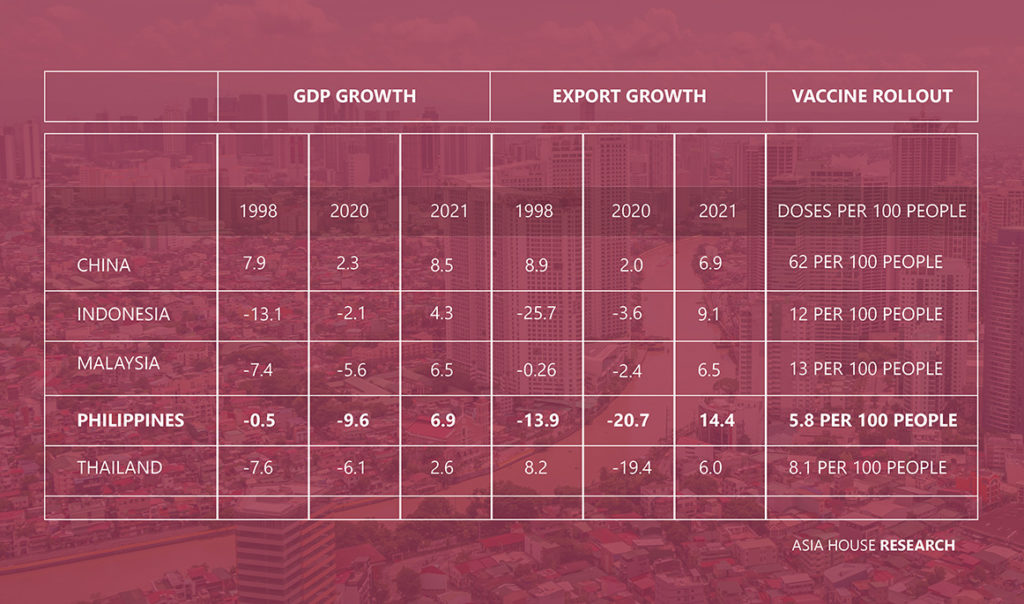Driving commercial and political engagement between Asia, the Middle East and Europe
Driving commercial and political engagement between Asia, the Middle East and Europe
Driving commercial and political engagement between Asia, the Middle East and Europe

Ahead of the Asia House briefing with Carlos Dominguez III, Secretary of Finance, the Philippines, on Wednesday 16 June, Phyllis Papadavid, Head of Research and Advisory at Asia House, takes a look at the forces shaping the country’s economy.
 Phyllis Papadavid
Phyllis Papadavid
Head of Research and Advisory
Phyllis Papadavid is a leading international economist and financial strategist with extensive research experience across the private and public sectors. She leads Asia House’s Research and Advisory work, driving the organisation’s research agenda and directing projects.
Key takeaways
– The Philippines’ economic relationships will shift in the near-to-medium term; crucially they lie at the intersection between US and Chinese interests.
– The Philippines’ economic geography makes it particularly important when it comes to regional geopolitics and trade growth.
– ASEAN has a role to play in mediating and formulating regional strategy as US-China regional economic competition is likely to build.
Southeast Asia’s economic recovery is important for the global economy and for the region’s geopolitics. This stems, in part, from the economies’ proximity to, and economic interdependence with, China – now expected to become the world’s largest economy by 2028. Territorial tensions in the South China Sea remain a key risk. All said, economic interdependence is likely to supersede geopolitical tensions and China will likely assert greater regional economic influence, perhaps partly at the expense of the US.
The Philippines could feel the two-way pull between China and the US particularly strongly given its geographical proximity to the former and its historical alliance with the latter. The COVID-19 crisis induced a growth collapse several times of that seen in the 1997-98 Asian financial crisis (see Figure 1). Its growth drivers, as well as its vaccine rollout, remain weak. Vaccine diplomacy also now seems to be a prominent factor, too, when it comes to its relationship with both the US and China – the Philippines needs further vaccine supply.
Figure 1: Economic developments in Southeast Asian Economies and China
 Source: International Monetary Fund World Economic Outlook, April 2021; Vaccination rates are as of June 14, 2021 and are sourced from Our World in Data.
Source: International Monetary Fund World Economic Outlook, April 2021; Vaccination rates are as of June 14, 2021 and are sourced from Our World in Data.
The US retains an advantage in its close and long alliance with the Philippines; and yet the relationship has become more distant, including in relation to the visiting forces agreement. In economic terms, the Philippines’ relationship with China, and with ASEAN trading partners, continues to grow and is likely to surpass its economic links with the US, despite any challenges in the implementation of regional agreements such as the Regional Comprehensive Economic Partnership (RCEP). We examine three reasons why this might be the case:
The US and China remain the Philippines’ top two export markets. Economic influence is also extended via the presence of the World Bank, as well as the Asian Development Bank. There could be underlying uncertainty when it comes to Philippine reliance on the US export market – not only has the US experienced an economic crisis, but in more structural terms, US incomes have seen both intermittent stagnation and higher inequality. In the light of this, despite the size of the US consumer market, diversification away from it could occur to cushion the economy from US shocks.
Chinese consumer demand could provide an alternative. In the medium-term, emerging and developing economy growth is not expected to reverse the economic scarring from the pandemic. And yet, the recovery is expected to be strongest in East Asia and the Pacific, primarily due to strength in China according to the World Bank. Although China’s constellation of risks is broad, and there is still an ongoing rotation to domestic consumption as its growth engine, there is evidence of pent-up demand. China’s rise in skill-intensive wages suggests that consumption growth will show structural strength.
China has amassed goodwill with the Philippines in the economic realm; this is likely to continue and to have broader financial implications during future crises. The Asian financial crisis of 1997/98 marks a reference point: China did not devalue its currency to support its exports as Southeast Asian currencies crashed. There is also the belief that regional initiatives at the time were more helpful than the policies attached to IMF assistance. One illustration of this, in addition to other bilateral arrangements, has been the Chiang Mai Initiative Multilateralization (CMIM) establishing a common pool of emergency funding.
Post-COVID-19, stronger inflationary pressures are emerging. Unexpectedly tighter financial conditions may see increased demand for liquidity. Future crises will require deeper safety nets and insurance mechanisms that China and other partners may be more willing and/or able to provide – either through larger bilateral swap facilities within Asia, or through an emerging financial digital infrastructure. Digital transformation in the region will build resilience against shocks, particularly if it facilitates trade finance and digital currencies. The use of e-wallets rose a reported 5000 per cent in the Philippines during the pandemic.
The Regional Comprehensive Partnership Agreement (RCEP) constitutes ASEAN’s largest trade deal covering 30 per cent of the world’s GDP. It builds on a multi-decade increase in intra-regional trade in Southeast Asia. RCEP is expected to significantly reduce tariffs among member countries and incentivise cross-border investment flows. Intra-regional trade has increased to 25 per cent in the 2010s and ASEAN’s export space is expanding faster than the world average; further progress of regional integration among the ASEAN member states will constitute an additional contributing factor to regional export capacity.
RCEP will be particularly important for the Philippines. In the past, trade facilitation has been a key issue in the negotiation of its trade policies. The benefits of signing on to RCEP will be more fully realised with improved institutional capacity to facilitate trade – such as automating customs procedures, governance, logistics and countries of origin identification, which have been linked to premiums on Philippine import prices in the past. This type of capacity building will contribute to removing the trade barriers and improving the investment climate for export-oriented SMEs who cite a range of ICT and trade-related obstacles.
There remains a durable tie between the Philippines and the US that is likely to continue to shift. Some argue that the Philippine economy complements that of the US more than it does China’s, given linguistic similarities and that Chinese and Philippine exports often find themselves in competition in third markets. And yet, this is likely to be offset by the growing economic link whereby China becomes the region’s key export market given its consumer base. ASEAN represents a market of over half a billion people – fostering a regional strategy, that is informed by each member state, will be crucial in counterbalancing China and the US.
JOIN OUR MAILING LIST to receive Asia House insights, analysis and research direct to your inbox.
FIND OUT MORE about Asia House’s research and advisory services.
